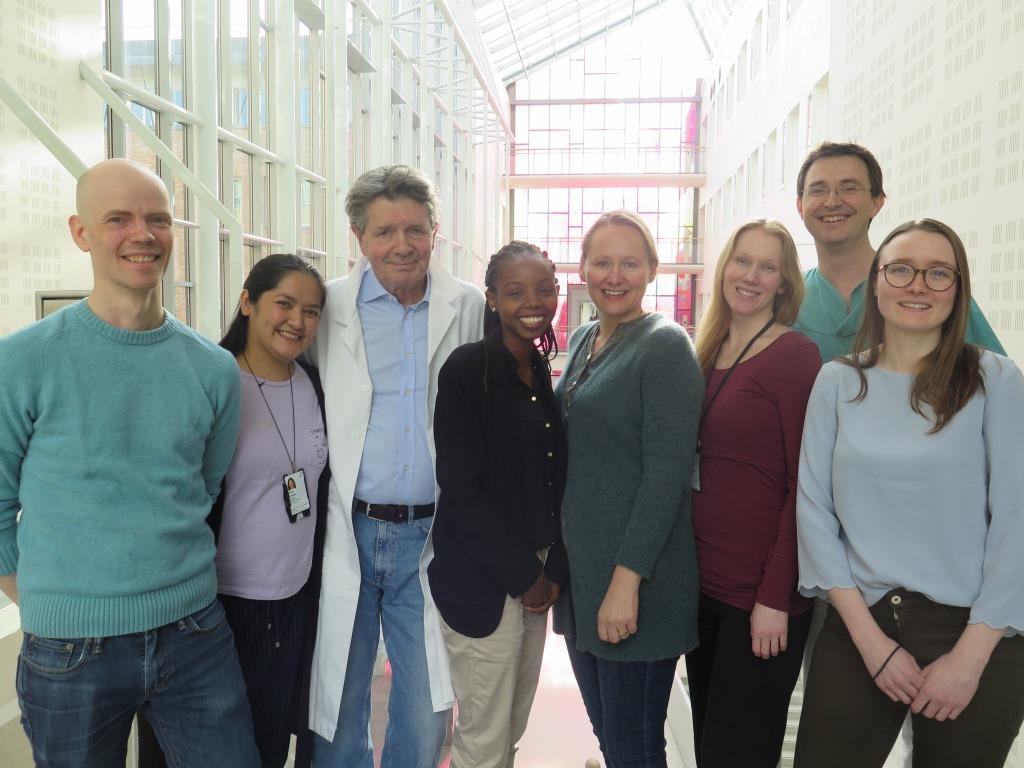VML Research Projects
Background
Fifteen years ago we showed for the first time that stem cells from the adult human brain can differentiate into functional neurons, and that it is possible to generate a small nervous system with numerous neurons that fire action potentials and communicate via synapses, from a single stem cell harvested from the adult human brain (Moe et al Brain, 2005;128:2189-99, Westerlund et al Exp Cell Res. 2003; 289:378-83, Moe at al Neurosurgery 2005;56:1182-8).
Simultaneously we started to grow cells from GBMs. A population of cells from these tumors turned out to have stem cell-like properties. We showed that a GBM only can be transferred from one animal to another by transplantation of cells from the GSC subpopulation, in keeping with other results indicating that it is this subpopulation that is responsible for rencurrence, growth and drug resistance. We have therefore characterized GSCs quite extensively (Varghese et al Neurosurgery. 2008;63:1022-33; Vik-Mo et al,Neuro Oncol, 2010 Dec;12:1220-30, Vik-Mo et al, Exp Cell Res, 2011 Apr 15;317:1049-59, Joel et al,Dev Dyn, 2013;242:1078-93, Sandberg et al,Exp Cell Res, 2013 15;319:2230-43, Fayzullin et al Exp Cell Res. 2016 10;349:199-213, Mughal et al, Neoplasia. 2018;20:643-6569).

Photo: OUS
Development of a stem cell-based vaccine in patients with brain cancer:
We developed the first clinical protocol that targeted stem cells in a solid tumor by transducing dendritic cells from patients with mRNA from their own GBM stem cells. This significantly improved clinical outcome (Vik-Mo et al, Cancer Immunol Immunother. 2013;62:1499-509). One out of four of the patients are still alive.
The responders have a median survival of 7 years and are still recurrence free. A randomized trial of the vaccine was certified by all required authorities and started in the spring of 2018. Our intention in the current study is also to clarify why some patients respond and others do not; by in-depth studies of individual tumors and treatment responses.
Individualized systems medicine strategy to target GSCs in patients with recurrent glioblastoma:
In collaboration with our partners at the Finnish Institute for Molecular Medicine, we are combining the novel technical possibilities of high-throughput screening and deep sequencing with our established know-how on patient specific tumor stem cell cultures. Exploring a panel of 525 drugs established in clinical use, as well as drugs in early-phase development, at five different concentrations, we have screened stem cells from individual tumors for drug sensitivity. The approach has been coined Individualized Systems Medicine. This study has shown that GBMs from individual patients are very heterogenous with respect to drug sensitivity. A manuscript has been submitted for publication.
A clinical trial where we treat patients based on the result from this screening has been planned and applications to relevant authorities are being sent.
Coordinated undermining of survival paths with nine repurposed drugs (CUSP9) and temozolomide in patient-derived GBM samples:
A major barrier to effective treatment in glioblastoma is the simultaneous activity of multiple survival and growth-promoting mechanisms. A conceptually new treatment approach has emerged focusing on coordinated blockade of the native survival paths of GBMs. The coordinated blockade is undertaken by nine clinically well-known and repurposed drugs concomitant with the cytotoxic and standard of care, temozolomide, in a drug cocktail termed CUSP9. We have evaluated the in vitro efficacy of CUSP9 in patient-derived GBM samples using clinical relative drug concentrations across several different experimental cell assays. The coordinated approach has demonstrated a broad efficacy among several patient samples and experimental cell assays, and as the drugs have well- known safety profiles the results are intriguing for translation to patient treatment. A manuscript has been submitted for publication.
Characterization of invasive GCSs at the single cell level:
Glioblastomas are characterized by diffusely infiltrative growth. To investigate the invasive properties of glioblastoma cells we film cells while they invade into rodent brain slices or 3D-biomatrixes using time-lapse microscopy. We have identified subpopulations of cells with different invasive potentials. These cells display specific movement patterns and morphology. This is part of a PhD project where the last paper has been submitted and the thesis is expected to be submitted in 2018.
Molecular targeting of cancer stem cells in glioblastoma:
By performing a systematic comparison of gene expression in adult human neural stem cells and GSCs, we have identified differentially expressed genes that may have the potential as new and specific targets for treatment of glioblastoma. Our results from exploring several of these genes and pathways in-depth, suggest a functional role for the Wnt signaling pathway, PBK and NAT12/NAA30 in GBM. As a strategy to more efficiently and directly identify targets that are likely to trigger a therapeutic response, we are currently focusing on genetic high throughput loss-of function screening as tools to identify both individual and shared target hits in patient derived GSC cell cultures.
Funding:
- Norwegian Cancer Society
- The Norwegian Research Council
- South-Eastern Regional Health authorities
- OUH, Dept. of Neurosurgery
